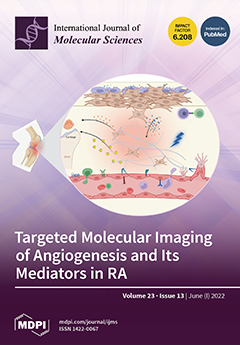It is known that selenium nanoparticles (SeNPs) obtained on their basis have a pleiotropic effect, inducing the process of apoptosis in tumor cells, on the one hand, and protecting healthy tissue cells from death under stress, on the other hand. It has been
[...] Read more.
It is known that selenium nanoparticles (SeNPs) obtained on their basis have a pleiotropic effect, inducing the process of apoptosis in tumor cells, on the one hand, and protecting healthy tissue cells from death under stress, on the other hand. It has been established that SeNPs protect brain cells from ischemia/reoxygenation through activation of the Ca
2+ signaling system of astrocytes and reactive astrogliosis. At the same time, for a number of particles, the limitations of their use, associated with their size, are shown. The use of nanoparticles with a diameter of less than 10 nm leads to their short life-time in the bloodstream and rapid removal by the liver. Nanoparticles larger than 200 nm activate the complement system and are also quickly removed from the blood. The effects of different-sized SeNPs on brain cells have hardly been studied. Using the laser ablation method, we obtained SeNPs of various diameters: 50 nm, 100 nm, and 400 nm. Using fluorescence microscopy, vitality tests, PCR analysis, and immunocytochemistry, it was shown that all three types of the different-sized SeNPs have a cytoprotective effect on brain cortex cells under conditions of oxygen-glucose deprivation (OGD) and reoxygenation (R), suppressing the processes of necrotic death and inhibiting different efficiency processes of apoptosis. All of the studied SeNPs activate the Ca
2+ signaling system of astrocytes, while simultaneously inducing different types of Ca
2+ signals. SeNPs sized at 50 nm- induce Ca
2+ responses of astrocytes in the form of a gradual irreversible increase in the concentration of cytosolic Ca
2+ ([Ca
2+]
i), 100 nm-sized SeNPs induce stable Ca
2+ oscillations without increasing the base level of [Ca
2+]
i, and 400 nm-sized SeNPs cause mixed patterns of Ca
2+ signals. Such differences in the level of astrocyte Ca
2+ signaling can explain the different cytoprotective efficacy of SeNPs, which is expressed in the expression of protective proteins and the activation of reactive astrogliosis. In terms of the cytoprotective efficiency under OGD/R conditions, different-sized SeNPs can be arranged in descending order: 100 nm-sized > 400 nm-sized > 50 nm-sized.
Full article






